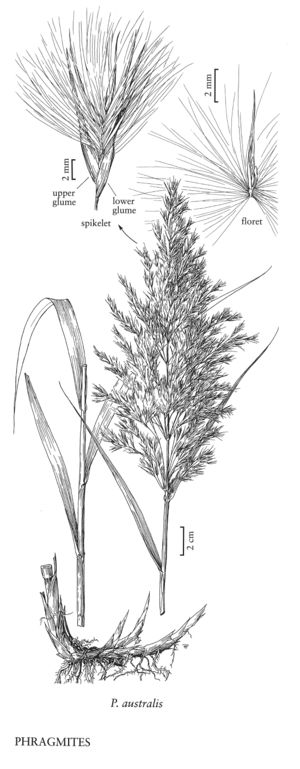Difference between revisions of "Phragmites australis"
FNA>Volume Importer |
RevisionBot (talk | contribs) m (Bot: Adding category Revised Since Print) |
||
| (5 intermediate revisions by 3 users not shown) | |||
| Line 24: | Line 24: | ||
-->{{Treatment/Body | -->{{Treatment/Body | ||
| − | |distribution=Conn.;N.J.;N.Y.;Wash.;Va.;Del.;D.C;Wis.;W.Va.;Pacific Islands (Hawaii);Md.;Fla.;Wyo.;N.H.;N.Mex.;Ind.;La.;Alta.;B.C.;Man.;N.B.;Nfld. | + | |distribution=Conn.;N.J.;N.Y.;Wash.;Va.;Del.;D.C.;Wis.;W.Va.;Pacific Islands (Hawaii);Md.;Fla.;Wyo.;N.H.;N.Mex.;Ind.;La.;Alta.;B.C.;Man.;N.B.;Nfld. and Labr. (Labr.);N.S.;N.W.T.;Ont.;P.E.I.;Que.;Sask.;N.C.;Nebr.;Tenn.;Pa.;R.I.;Nev.;Mass.;Maine;Vt.;Puerto Rico;Colo.;Miss.;Calif.;Ala.;Kans.;N.Dak.;Okla.;S.Dak.;Ark.;Ill.;Ga.;Iowa;Ariz.;Idaho;Mich.;Ohio;Minn.;Mont.;Oreg.;S.C.;Tex.;Utah;Mo.;Ky. |
|discussion=<p><i>Phragmites australis</i> grows in wet or muddy ground along waterways, in saline or freshwater marshes, and in sloughs throughout North America. Its tall, leafy, often persistent culms and plumose panicles make it one of our easier species to recognize. In Florida, <i>Neyraudia reynaudiana</i> is sometimes mistaken for <i>P. australis</i>, but the former has glabrous internodes and pilose lemmas.</p><!-- | |discussion=<p><i>Phragmites australis</i> grows in wet or muddy ground along waterways, in saline or freshwater marshes, and in sloughs throughout North America. Its tall, leafy, often persistent culms and plumose panicles make it one of our easier species to recognize. In Florida, <i>Neyraudia reynaudiana</i> is sometimes mistaken for <i>P. australis</i>, but the former has glabrous internodes and pilose lemmas.</p><!-- | ||
--><p>It is also one of the most widely distributed flowering plants, growing in most temperate and tropical regions of the world, spreading quickly by rhizomes. Once established, it is difficult to eradicate. Its uses include thatching, lattices, arrow shafts, construction boards, mats, and erosion control, and it was used in the past to make cigarettes and superior pen quills.</p><!-- | --><p>It is also one of the most widely distributed flowering plants, growing in most temperate and tropical regions of the world, spreading quickly by rhizomes. Once established, it is difficult to eradicate. Its uses include thatching, lattices, arrow shafts, construction boards, mats, and erosion control, and it was used in the past to make cigarettes and superior pen quills.</p><!-- | ||
| Line 58: | Line 58: | ||
|illustrator=Linda A. Vorobik;Hana Pazdírková | |illustrator=Linda A. Vorobik;Hana Pazdírková | ||
|illustration copyright=Utah State University | |illustration copyright=Utah State University | ||
| − | |distribution=Conn.;N.J.;N.Y.;Wash.;Va.;Del.;D.C;Wis.;W.Va.;Pacific Islands (Hawaii);Md.;Fla.;Wyo.;N.H.;N.Mex.;Ind.;La.;Alta.;B.C.;Man.;N.B.;Nfld. | + | |distribution=Conn.;N.J.;N.Y.;Wash.;Va.;Del.;D.C.;Wis.;W.Va.;Pacific Islands (Hawaii);Md.;Fla.;Wyo.;N.H.;N.Mex.;Ind.;La.;Alta.;B.C.;Man.;N.B.;Nfld. and Labr. (Labr.);N.S.;N.W.T.;Ont.;P.E.I.;Que.;Sask.;N.C.;Nebr.;Tenn.;Pa.;R.I.;Nev.;Mass.;Maine;Vt.;Puerto Rico;Colo.;Miss.;Calif.;Ala.;Kans.;N.Dak.;Okla.;S.Dak.;Ark.;Ill.;Ga.;Iowa;Ariz.;Idaho;Mich.;Ohio;Minn.;Mont.;Oreg.;S.C.;Tex.;Utah;Mo.;Ky. |
|reference=None | |reference=None | ||
|publication title= | |publication title= | ||
|publication year= | |publication year= | ||
|special status= | |special status= | ||
| − | |source xml=https:// | + | |source xml=https://bitbucket.org/aafc-mbb/fna-data-curation/src/200273ad09963decb8fc72550212de541d86569d/coarse_grained_fna_xml/V25/V25_22.xml |
|subfamily=Poaceae subfam. Arundinoideae | |subfamily=Poaceae subfam. Arundinoideae | ||
|tribe=Poaceae tribe Arundineae | |tribe=Poaceae tribe Arundineae | ||
| Line 70: | Line 70: | ||
}}<!-- | }}<!-- | ||
| − | -->[[Category:Treatment]][[Category:Phragmites]] | + | --> |
| + | |||
| + | [[Category:Treatment]] | ||
| + | [[Category:Phragmites]] | ||
| + | [[Category:Revised Since Print]] | ||
Latest revision as of 17:29, 28 May 2021
Culms 1-4 m tall, 0.5-1.5 cm thick, erect. Ligules about 1 mm, composed of hairs; blades 15-40 cm long, 2-4 cm wide, long-acuminate, disarticulating from the sheath at maturity. Panicles 15-35 cm long, 8-20 cm wide, ovoid to lanceoloid, often purplish when young, straw-colored at maturity; rachilla hairs (4)6-10 mm. Spikelets with 3-10 florets. Lower glumes 3-7 mm; upper glumes (4)5-10 mm; lemmas 8-15 mm, glabrous, linear, margins somewhat inrolled, apices long-acuminate; paleas 3-4 mm, membranous; anthers 1.5-2 mm, purplish; styles persistent. Caryopses 2-3 mm, rarely maturing. 2n = 36, 42, 44, 46, 48, 49-54, 72, 84, 96, 120.
Distribution
Conn., N.J., N.Y., Wash., Va., Del., D.C., Wis., W.Va., Pacific Islands (Hawaii), Md., Fla., Wyo., N.H., N.Mex., Ind., La., Alta., B.C., Man., N.B., Nfld. and Labr. (Labr.), N.S., N.W.T., Ont., P.E.I., Que., Sask., N.C., Nebr., Tenn., Pa., R.I., Nev., Mass., Maine, Vt., Puerto Rico, Colo., Miss., Calif., Ala., Kans., N.Dak., Okla., S.Dak., Ark., Ill., Ga., Iowa, Ariz., Idaho, Mich., Ohio, Minn., Mont., Oreg., S.C., Tex., Utah, Mo., Ky.
Discussion
Phragmites australis grows in wet or muddy ground along waterways, in saline or freshwater marshes, and in sloughs throughout North America. Its tall, leafy, often persistent culms and plumose panicles make it one of our easier species to recognize. In Florida, Neyraudia reynaudiana is sometimes mistaken for P. australis, but the former has glabrous internodes and pilose lemmas.
It is also one of the most widely distributed flowering plants, growing in most temperate and tropical regions of the world, spreading quickly by rhizomes. Once established, it is difficult to eradicate. Its uses include thatching, lattices, arrow shafts, construction boards, mats, and erosion control, and it was used in the past to make cigarettes and superior pen quills.
Phragmites karka (Retz.) Trin. ex Steud. is sometimes attributed to the Flora region. It supposedly dif¬fers from P. australis as shown below, but all the characters intergrade. For this reason, they are treated here as components of a single species.
Selected References
None.
Lower Taxa
Key
| 1 | Blades smooth on the abaxial surfaces, the apices filiform, flexible; rachilla hairs 6-10 mm long; upper glumes 5-10 mm long | Phragmites australis |
| 1 | Blades scabrous on the abaxial surface, the apices attenuate, stiff; rachilla hairs 4-7mm long; upper glumes 4-6 mm long | Phragmites karka |
